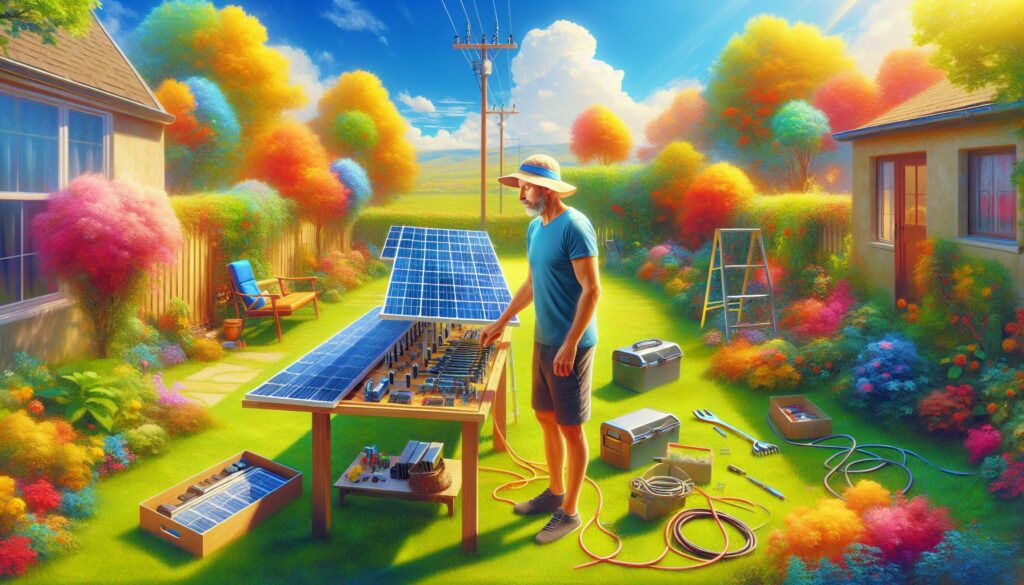Have you ever thought about harnessing the sun’s power right in your backyard? DIY solar projects offer a fantastic way to tap into renewable energy while saving money on your utility bills. Whether you’re a seasoned DIY enthusiast or just starting out, these projects can be both fun and rewarding.
From simple solar water heaters to more complex solar panel installations, there’s something for everyone. I’ve found that diving into these projects not only helps the environment but also provides a sense of accomplishment. Let’s explore some exciting DIY solar ideas that can brighten your home and reduce your carbon footprint.
- Understanding DIY Solar Projects: These projects allow individuals to harness solar energy at home, ranging from simple solar water heaters to advanced solar panel installations.
- Cost Efficiency: DIY solar projects can substantially reduce energy bills, with examples like solar water heaters cutting costs by up to 50%. Customizing setups based on budget offers additional savings.
- Environmental Impact: Utilizing solar energy minimizes carbon footprints, as each kilowatt-hour generated cuts down approximately 0.5 kg of CO2 emissions, contributing to cleaner air and climate change mitigation.
- Types of Projects: Popular DIY solar projects include solar panel installations, solar water heaters, and solar lighting—all catering to different skill levels and energy needs.
- Success Tips: Careful planning, high-quality material selection, and understanding local regulations are key to executing successful DIY solar projects.
- Addressing Challenges: Be prepared for technical difficulties and regulatory hurdles by researching thoroughly and consulting manuals or local authorities to ensure compliance and effective installation.
DIY Solar Projects
DIY solar projects empower individuals to utilize solar energy effectively while minimizing costs. Many options exist, catering to various skill levels and interests. Simple projects, like solar water heaters, involve basic materials and tools, making them ideal for beginners. More complex installations, such as solar panel arrays, cater to those with advanced skills and offer greater energy efficiency.
These projects typically fall into several categories:
- Solar Water Heaters: These systems use solar collectors to heat water for residential use. Installing a solar water heater can reduce energy bills significantly.
- Solar Panel Installations: Setting up solar panels enables homeowners to generate electricity. This project typically requires more investment and technical skills.
- Solar Lighting Solutions: Adding solar-powered lights enhances outdoor spaces while increasing safety. These installations are straightforward and require minimal components.
- Solar-Powered Gadgets: Building small solar-powered devices showcases solar technology’s versatility. Options include solar chargers for electronics and garden fountains.
Engaging in DIY solar projects promotes sustainability and fosters a sense of independence. Each project contributes to reducing reliance on traditional energy sources, highlighting the potential for significant environmental benefits.
Benefits Of DIY Solar Projects
DIY solar projects provide a practical approach to harnessing renewable energy, offering both personal and environmental benefits. Engaging in these projects not only enhances self-sufficiency but also promotes sustainability.
Cost Savings
Cost savings represent a significant advantage of DIY solar projects. By investing in solar solutions, like solar water heaters or panels, I cut monthly energy bills considerably. For instance, installing a basic solar water heater can reduce heating costs by up to 50%. Additionally, these projects often require lower initial investments compared to fully installed systems, allowing me to customize my solar setup according to my budget. Furthermore, potential tax credits or rebates can enhance these savings, making solar technology even more accessible.
Environmental Impact
Environmental impact stands out as another key benefit of DIY solar projects. By using solar energy, I actively reduce my carbon footprint and decrease reliance on fossil fuels. Each kilowatt-hour (kWh) generated from solar energy helps eliminate approximately 0.5 kg of carbon dioxide emissions. Numerous studies indicate that widespread adoption of solar technology contributes to cleaner air and mitigates climate change effects. Each small DIY project, from solar-powered lights to complete solar panel arrays, fosters a cleaner environment and promotes a sustainable future.
Popular Types Of DIY Solar Projects
Various DIY solar projects cater to different skills and needs, allowing for personalized energy solutions. Here’s a look at some popular types.
Solar Panels Installation
Solar panel installation ranks among the most impactful DIY endeavors. Homeowners can generate their own electricity, reducing reliance on the grid. Basic installations typically involve mounting the panels on a roof or a ground setup. Individuals need to connect the panels to an inverter and, if desired, battery storage for off-grid capabilities. Costs vary, but many spend between $5,000 and $15,000 for a complete system. With tax incentives and long-term energy savings, it’s a worthwhile investment.
Solar Water Heaters
Solar water heaters offer a reliable way to cut heating expenses. DIYers can create a solar collector using materials like copper pipes and insulation. These systems circulate water through the collector, where it’s heated by sunlight before being stored in a tank. Installing a solar water heater can reduce water heating costs by up to 50% annually. The average cost ranges from $1,500 to $3,000, making it an accessible option for most households.
Solar Lights
Solar lighting solutions enhance outdoor spaces while providing utility savings. Solar lights require minimal setup, often needing only placement in sunny areas. Equipped with photovoltaic cells, these lights store energy during the day for nighttime use. Options range from pathway lights to security lights, with prices starting around $20 to $200 per unit. These projects improve safety and aesthetics without adding to monthly energy bills, making them an attractive choice for many.
Tips For Success In DIY Solar Projects
Successful DIY solar projects require careful planning and the right materials. Following specific strategies can enhance project efficiency and results.
Planning And Design
Planning addresses key factors like location, energy needs, and system type. I assess my energy consumption to determine how much energy my solar project should generate. I create a detailed design, including dimensions, layout, and specifications for components. Reviewing local regulations ensures my project complies with zoning and permitting requirements. Utilizing design software or apps can provide useful visualizations and improve accuracy.
Selecting Materials
Selecting high-quality materials contributes to project durability and efficiency. I choose solar panels with high efficiency ratings and preferred warranties, as they affect long-term performance. I opt for robust mounting structures that withstand local weather conditions. Cables and connectors should meet electrical standards; using durable components ensures reliability. I always research suppliers to compare prices and ensure I’m purchasing genuine products.
Common Challenges And Solutions
I’ve encountered some common challenges in DIY solar projects, but solutions exist to address these issues effectively.
Technical Difficulties
Technical difficulties often arise when working on solar projects. Confusion occurs with wiring solar panels, integrating inverters, or setting up batteries. To solve wiring issues, I refer to clear diagrams and tutorials specific to my project type. Testing connections with a multimeter ensures the setup works correctly. If integrating inverters poses a problem, consulting user manuals and online forums provides insight and support. For battery installation, selecting compatible components based on my solar system’s voltage rating is crucial to avoid complications.
Regulatory Considerations
Regulatory considerations may complicate DIY solar projects. Local building codes and zoning regulations dictate project requirements. To navigate these regulations, I contact local authorities before starting any project. I ensure compliance with permit requirements and understand any incentives available. Researching interconnection agreements with utility companies is vital for connecting my system to the grid. Engaging with local solar advocacy groups offers additional resources and support in understanding and adhering to these regulations.
Embracing DIY solar projects has transformed my approach to energy consumption. There’s something incredibly satisfying about creating sustainable solutions that not only cut costs but also contribute to a healthier planet. Whether I’m installing a solar water heater or setting up solar lights in my backyard, each project brings a sense of achievement.
The journey into solar energy doesn’t have to be daunting. With the right planning and resources, anyone can dive into these rewarding projects. I encourage you to explore various options and find what fits your lifestyle best. By harnessing the power of the sun, we can all take meaningful steps toward sustainability while enjoying the benefits of reduced energy bills.

